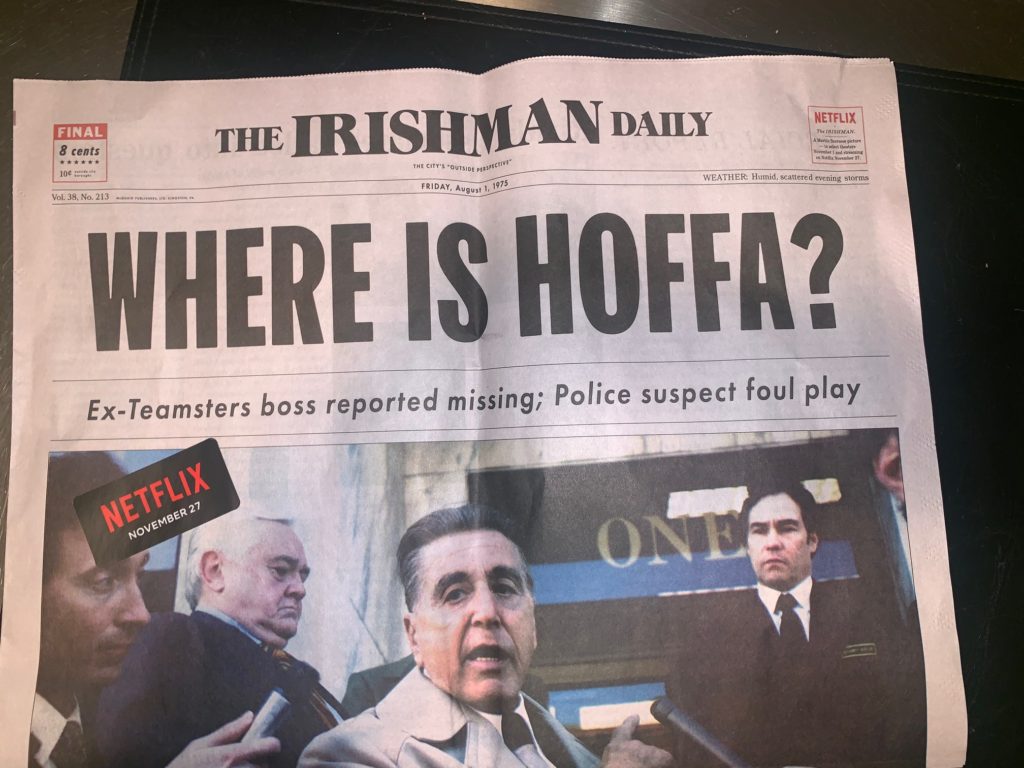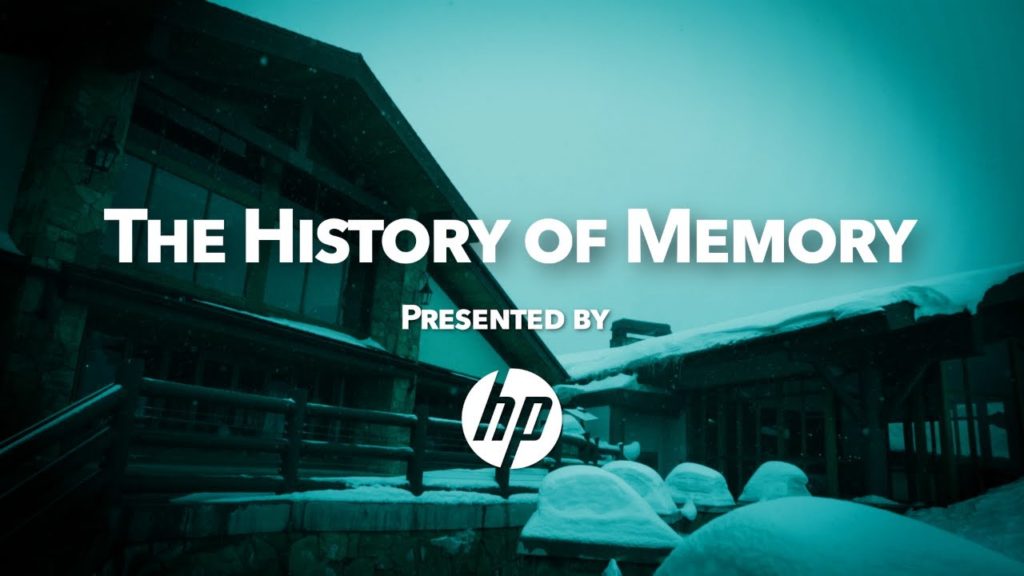
The Irishman opened this past Friday, and I finally saw it this week at the Belasco Theater. This is not a review, but it was great, and not just because it’s a Scorsese film with a great cast (Joe Pesci in particular), but because I saw it on Broadway, in a storied theater, that was a much more pleasant experience than seeing it at AMC, Regal or any other big chain theater. I mean, heck, there were only 2 pre-show trailers, no ads and it cost less than most movies in NYC. And Netflix added great touches, like phone booths in the lower lobby that played clips from the film, actual print newspapers with Hoffa headlines and funny fake ads, and some gag props on the bar that referenced key scenes in the movie (no spoilers here). A great experience all around.
And of course, the big theaters are not too happy with this situation, as the NYT reports. As you probably already know, the big chains usually want a 90 day window between a film’s premiere in theaters and its premiere online with Netflix (or anyone else). This doesn’t mean they will play the film in theaters for 90 days, but that they think too few people will go on day one if they know they can see it on SVOD just 90 days later (cuckoo cachoo). But this time, a couple of the chains were willing to give some ground and give a window of…wait for it… 60 days! Netflix rightfully said F-U, and is launching the film to subscribers just 26 days later. Which is about as long of a window as any consumer can possibly be expected to wait.
John Fithian, the head of NATO (no, not that NATO, this one represents all the big theater chains), was all aflutter, saying it was “a disgrace” that Netflix wouldn’t compromise with the theaters. No, John, a disgrace is me walking up ten floors at an AMC/Regal where the escalator is broken, to stand in line to pay astronomical prices for a popcorn from the only kid on duty for 20 theaters worth of patrons, only to sit in a broken recliner seat, with sticky floors and a movie being projected too dimly and with the AC only intermittently working. That’s a disgrace. It’s also a disgrace to blame Netflix for your idiotic windowing system.
Scorsese tried to make this movie in the studio system, and no one would put up the $159 Million budget. Netflix would. And that means it’s up to Netflix how it releases its films and how they window their films. The theaters tried to strong arm them, but Netflix found an elegant solution in the Belasco and smaller theaters. The chains were afraid of losing the 60-90 day window for all other movies, but in their short-sightedness, have just given consumers a “window” onto an alternate, better way to see movies than the usual crappy multiplex experience. They’ll likely remember how much better this was, and hope for it again. Luckily, Netflix is also renting out the Paris Theater in NYC for other films, and the Egyptian in LA as well, meaning we’ll get plenty of opportunities to see a film in a better venue. And they made deals with many smaller theaters in NYC/LA and across the country – and while they usually aren’t the Belasco, they are usually more pleasant experiences, so there are alternate options and better approaches here.
What would be smarter for the chains would be to step up and behave like Netflix – in reverse. Sure, AMC’s stock price isn’t as strong as Netflix’s, but they need to make major moves to stay relevant, and they need to start spending money on something other than 4DX seats that spit on you, shake and spray perfume. AMC (and Regal, Cinemark, etc.) should start funding movies and make them only available in their theaters and to their AMC Stubs (or similar) members. AMC is already launching a streaming service to its Stubs members anyways, with most of the Studios offering library content, and while the only have 20 million households as members now (compared to Netflix’s 158M), this would be one way to increase that number, while taking control of their destiny and getting some true cinematic masters like Scorsese to make films for them. They have the makings of an alternate system in place, so why not use it to their advantage, much like Netflix uses their subscriptions to their own?
They could even do it as a joint venture, like they did with Fathom, which is a JV between AMC, Regal, and Cinemark. If they’re willing to cough up $160M for a Scorsese movie and keep it in theaters for 90 days before putting it on AMC Stubs and Regal Unlimited, then they would make back the majority of the box office and any subscription revenue – while giving subscribers a reason to stay subscribed, or to join in the first place.
Sure, there are some legal hurdles to this, and a lot of logistics to overcome – not least of which is the fact they only know how to pop popcorn, not make something creative (see their pre-show advertisements), but these are obstacles they need to destroy before the streamers destroy them. (Ok, I actually think theaters are gonna be fine on revenue from other blockbusters, but you get my point). But, no, I suspect the main reason they won’t do this is that they know they would soon have first-hand data telling them their customers can’t wait 90 days either, because no one should.
WHAT I’M READING: FILM/ STREAMING:
Walmart Eyes Vudu Sale – Seems like huge news to me. Yeah, I know not as many people use Vudu as the others, but they actually have a pretty strong offering, with early access to titles, lots of bundling and deals, and it is a solid VOD and AVOD offering. With lots of potential – when tied to Walmart – for direct linking of sales from videos. But apparently the world is not just embracing streaming, but abandoning transactional enough to make it a losing proposition for Walmart.
DocNYC runs Nov 6-15. Check out the website for full details and showtimes. Also make sure to check out the panels and talks at DocNYC Pro. My faves of what I’ve seen: American Factory, The Biggest Little Farm, The Elephant Queen, Honeyland, Midnight Family, Midnight Traveler, and Searching for Mr Rugofff. And that I want to see: Buster Williams, Bass to Infinity, Kifaru, Letter to the Editor, and The Story of Plastic.
How to Dissolve your Film’s LLC? – Lindsay Spiller recently wrote a nice, easy to understand break-down of the step’s you need to take to wind down and close up your film’s LLC after it’s great success. Very helpful stuff (I’m following his rules on a project now).
Streamers chasing subscribers are giving it away free– in hopes they can hit their targets and maybe you’ll subscribe in the future. I see a subscriber bubble ahead
The Women Who Helped Build Hollywood– the New Yorker reviews a few books on the history of women in early Hollywood, and they had many more important roles than you might expect given the inequities we see today.

James Dean being digitally resurrected for a new film – Collider reports on how an agency has licensed his likeness for becoming a digital character in a new movie. I’ve been saying this is coming for quite some time, and before long, “new” actors will have trouble getting work, as it’s easier to add in a more famous digital player. And before long, a robot will craft most of that scene too. As the author puts it best: “Running through my head in all of this is the iconic Jurassic Park line from Ian Malcolm: “Your scientists were so preoccupied with whether or not they could, they didn’t stop to think if they should.”
Character posters are ruining film marketing – says the Guardian,and I agree. These are those annoying posters like “Florence Pugh is Amy in Little Women” with a big blow-up of her face. A terrible marketing trend that is becoming overused. Not as bad as the twenty faces on a poster version, being used to satisfy actor’s egos, but pretty close.
Some Film Fests are Exploiting Filmmakers – The Hollywood Reporter ran this long piece on “under the radar” festivals that are either fake or close to it, and who charge a lot of money for screenings, passes, hotels, etc. It seems like everyone I know has been sharing this on social media, but the funny thing is they didn’t even name some of the more egregious examples out there. Most seasoned filmmakers/producers and industry folks know these bad ones and will tell you off the record of who to avoid. Make sure to get references from other filmmakers on any fest you aren’t sure about – look up their catalogues online and pop an email to a few filmmakers to get info if you don’t know the festival’s reputation. There are a lot of scams to avoid.
WHAT I’M READING: BRANDED CONTENT

9 tips for brands on commissioning short films or series: A great post on BrandStorytelling by Sarah Klein and Tom Mason of Redglass Pictures who recently made History of Memory with HP, and won the TribecaX award as well. They break down all the things you need to think about before you even call a producer/filmmaker. It’s also important for filmmakers generally to read this – great tips on thinking about your story, your audience and your distribution strategy.
Check out BrandStorytelling ‘s new BrandVoice in Forbes – a new resource for all things brands and content. From the site: “We believe that a new era of media and marketing is rapidly emerging, one empowered by technology and driven by creative storytelling. What we see are brands taking a bold stride away from interruptive advertising towards content that provides value in the way of information and entertainment. Our mission is to encourage a higher level of collaboration amongst advertisers, agencies, media partners and creators, leading to a richer media environment for all.”
WHAT I’M READING: Miscellany
We Company may be imploding, but it’s also launching a gaming company – The Verge reports that the company has been filing some patents and posting jobs for “Play by We,” which looks like a housing/training facility for gamers, and maybe games later. If they exist at the end of the year, that is.
Social tagging: branded content > DocNYC > NATO > Netflix > theaters > vudu > Windows